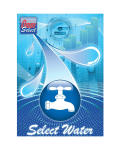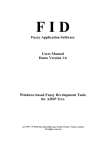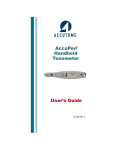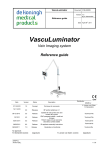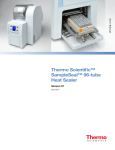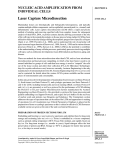Download ST. JOSEPH MEDICAL CENTER LABORATORY SERVICES
Transcript
ST. JOSEPH MEDICAL CENTER LABORATORY SERVICES LOCATION: Clinical Laboratory: Hospital (Ground Floor) Anatomic Pathology: Ambulatory Services Building (Second Floor) Morgue/Autopsy Suite: Hospital (2nd Floor, near Physical Medicine entrance) HOURS: Routine Work: 8:00 a.m. to 4:30 p.m., seven days per week. (Exceptions: Histopathology; closed Sundays; Flow, Serology, Cytopathology: closed Saturdays and Sundays) STAT Work: Around the clock, seven days per week. INFORMATION/SCHEDULING: Blood Bank: Clinical Laboratories (all sections) Cytopathology Pathologists Surgical/Autopsy/Pathology 410-337-1746 410-337-1710 410-337-1735 410-337-1717 410-337-1717 STAFF: Medical Director Administrative Director: Laboratory Manager: Associate Pathologists: BLOOD BANK: Section Head: Supervisor: CHEMISTRY/URINALYSIS: Section Head: Supervisor: Lead Technologist: CYTOPATHOLOGY: Section Head: Supervisor: FLOW CYTOMETRY: Section Head: James W. Eagan, Jr., M.D. Kay Buchanan, Ph.D, MT (ASCP) Christian Rizo, MBA, HTL (ASCP) Steven Axe, M.D. Fowzia Taqi, M.D. David A. Brinker, M.D. Zhen Fan, M.D. Fowzia Taqi, M.D. Nancy Stec, MA, MT (ASCP)SBB Steven Axe, M.D. Marene Paul, MS, MT (ASCP) Jeanette Clayton, MT (ASCP) Michael J. Dugan, MT Sharon Barr, MT (ASCP) Fowzia Taqi, M.D. Jean Wright, BS, CT (ASCP) Louise Kirby, CT (ASCP) Steven J. Axe, M.D. 2 FRONT DESK: Section Head: Supervisor: HEMATOLOGY: Section Head: Supervisor: Lead Technologists: Kay Buchanan, Ph.D, MT (ASCP) Lucia A. France Steven Axe, M.D. Marene Paul, MS, MT (ASCP) Jeanette Clayton, MT (ASCP) Michael J. Dugan, MT HISTOLOGY: Section Head: Supervisor: Fowzia Taqi, M.D. Paula Wilder, BS HTL(CM), ASCP LAB INFORMATION SERVICES Coordinator: Jason Smith, MS, C(ASCP) MICROBIOLOGY: Section Head: Supervisor: Lead Technologist: David A. Brinker, M.D. Jessica Reinhardt, MT, CLS [(M) NCA] Betty Chin, MT PHLEBOTOMY: Section Head: Supervisor: Kay Buchanan, Ph.D, MT (ASCP) Angela D. Dodson POINT OF CARE: Section Head: Coordinator: Dr. Zhen Fan, M.D. Eileen Farrish, MS, MT(ASCP) SATELLITE LABORATORIES and OUTREACH SERVICES: Section Head: Kay Buchanan, Ph.D, MT (ASCP) Supervisor: Lucia A. France SEROLOGY: Section Head: Supervisor: Steven Axe, M.D. Jessica Reinhardt, MT, CLS [(M) NCA] SPECIMEN REFERRAL: Section Head: Supervisor: Kay Buchanan, Ph.D, MT (ASCP) Lucia A. France SURGICAL PATHOLOGY: Section Head: Secretarial Supervisor: James W. Eagan, Jr., M.D. Sandra Moran T:\123\ADMINISTRATION\LABORATORY\LABORATORY MANUAL\Current service manual files\St. Joseph Center Laboratory Services - Updated 8-07.doc 3 SPECIMEN LABELING REQUIREMENTS GENERAL Orders placed via the hospital computer system will generate specimen labels containing appropriate information. The specimen container type is stated on the label as well as special handling instructions (e.g. “PLACE ON ICE”). The label MUST be placed on the correct container and positioned lengthwise with the flat end (die cut) up to the stopper or cap safety skirt. All labels that are printed for a set of orders MUST be sent to the Laboratory even if there are more labels than containers. PATIENT IDENTIFICATION The patient’s name and date of birth must be confirmed to match that on the labels before any specimens are collected to assure proper patient identification. BLOOD BANK PATIENT IDENTIFICATION FOR CLINICAL CARE AND TREATMENT In all cases, patient identification and specimen labeling is to be done at the side of the patient. Patient identification is to be done simultaneously, reading aloud, by two persons who have been trained to the hospital patient identification policy. Both persons will then sign the Blood Bank request. 1. A computer label, addressograph label or hand printed label may be used. The information must be legible, correct (includes spelling) and complete (see #2). Any discrepancies from this will result in a re-draw being requested by the Blood Bank. 2. The patient’s wristband, specimen label and request are compared aloud for: - Patient First and Last Name (if a middle name or initial is used, they must agree) – Date of Birth – Patient Unit Number – Date of Collection 3. The request slip is signed by the actual phlebotomist in the indicated space, and co-signed (validation of name line) by the second person assisting in the patient identification and sample labeling. 4. The sample label is initialed using Meditech mnemonics of the actual phlebotomist. 5. The blood sample and requisition are sent immediately to the Blood Bank. 6. A qualified Blood Bank technologist will confirm that all identifying information (Patient Name, Unit Number, and Date of Birth) on the request form agrees with that on the specimen tube label. Any sample received by the Blood Bank found to have a discrepancy or incomplete, incorrect (includes spelling), illegible or missing information is to be discarded and a new sample requested. (Date of collection may be added after the collection if missing from the label.) 7. If signatures are missing from the slip or tube the sample is to be discarded and a new sample drawn. 8. A specimen label may not be altered, removed or replaced in any way. If incorrect, the sample will be discarded. A specimen label or original identification cannot be covered or over-labeled in any way. If there is evidence of over-labeling, the sample will be discarded and a new draw requested by the Blood Bank. T:\123\ADMINISTRATION\LABORATORY\LABORATORY MANUAL\Current service manual files\St. Joseph Center Laboratory Services - Updated 8-07.doc 4 MICROBIOLOGY Specimens must be properly labeled and received in sterile containers in order to be processed. Minimum information necessary is patient name, identification number, Doctor ordering culture or room number, date of collection and specimen type. Sterile containers and transport media are available from purchasing. Improperly labeled or unlabeled specimens are unacceptable for culture. The only exceptions will be for those specimens requiring an invasive procedure or instrumentation for collection. In these instances, the proper label must be brought down and verified in person by the nurse or physician. All changes must be initialed. Specimens must be sent in tightly sealed containers with no external spillage. Leaking, contaminated containers are a hazard to personnel and will not be accepted. If a container becomes contaminated during collection, wipe off with disinfectant before transporting to the laboratory. Disinfect specimen containers from isolation units with disinfectant and place in appropriate bag for transportation. Keep specimen containers upright. TOXICOLOGY/THERAPEUTIC DRUG SPECIMENS All tubes must have the following legible information on the label: 1. 2. 3. 4. 5. Patient’s first and last name. Room Number/Location Date Collection Time Time of last dosage, if therapeutic drug monitoring specimen T:\123\ADMINISTRATION\LABORATORY\LABORATORY MANUAL\Current service manual files\St. Joseph Center Laboratory Services - Updated 8-07.doc 5 ST. JOSEPH MEDICAL CENTER OUTPATIENT LABORATORY COLLECTION CENTERS St. Joseph Medical Center Medical Laboratory St. Joseph Professional Building Room 206, 7401 Osler Drive Telephone: 410-494-6446 Towson, Maryland 21204 Fax: 410-494-6445 Office Hours: Monday – Friday 7:30 a.m. – 4:00 p.m. St. Joseph Medical Center Medical Laboratory Osler Medical Building Room 103, 7600 Osler Drive Telephone: 410-337-1784 Towson, Maryland 21204 Fax: 410-427-2331 Office Hours: Monday – Friday 7:30 a.m. – 4:00 p.m. St. Joseph Medical Center Medical Laboratory O’Dea Medical Arts Building Suite 504, 7505 Osler Drive Telephone: 410-337-1763 Towson, Maryland 21204 Fax: 410-337-4520 Office Hours: Monday – Friday 7:30 a.m. – 5:00 p.m. St. Joseph Medical Center Medical Laboratory Professional Centre Suite 106, 120 Sister Pierre Drive Telephone: 410-494-6421 Towson, Maryland 21204 Fax: 410-494-6432 Office Hours: Monday – Friday 7:30 a.m. – 4:00 p.m. OUTREACH SERVICES Phlebotomy and testing services are provided to the following groups: 1. 2. 3. 4. 5. 6. 7. 8. Masonic Home of Maryland Presbyterian Home Edenwald Retirement Community Villa Assumpta/Villa Maria Nursing Home Brightview Retirement Communities – White Marsh & Mays Chapel Ridge Maples Assisted Living Holly Hill Nursing Home Morningside House of Satyr Hill T:\123\ADMINISTRATION\LABORATORY\LABORATORY MANUAL\Current service manual files\St. Joseph Center Laboratory Services - Updated 8-07.doc 6 SCOPE OF SERVICES DEPARTMENT OF PATHOLOGY LABORATORY I. II. Description: The Laboratory provides both inpatient and outpatient testing for both common and special laboratory tests. Additional specialized testing is performed in laboratories approved by the Medical Executive Committee. Location: A. Location: 1. Main Hospital a. Ground Floor (1) The Core Laboratory which includes the Stat, Chemistry and HematologyCoagulation Laboratories (2) The Blood Bank (3) Microbiology (4) Front Desk/Reception Area a. The Staff process outpatients for diagnostic testing and the distribution of laboratory results to inpatient and outpatient locations. b. Hours of Operation: Monday – Friday from 8:00 a.m. – 8:00 p.m. Saturday from 8:00 a.m. – 4:30 p.m. Sunday from 9:00 a.m. – 2:00 p.m. b. Second Floor (1) The Morgue and Autopsy Suite 2. Ambulatory Building (Second Floor) Anatomical Laboratories a. Surgical Pathology b. Histopathology c. Cytopathology d. Pathology Offices e. Immunology and Flow Cytometry 3. Satellite Laboratories Locations and Hours of Operation a. Hospital Campus (1) O’Dea Medical Arts Building 7505 Osler Drive, Suite 504 Towson, Maryland 21204 Phone: 410-337-1763; Fax: 410-337-4520 Monday – Friday: 7:00 a.m. – 5:00 p.m. (2) St. Joseph Professional Building 7401 Osler Drive, Room 206 Towson, Maryland 21204 Phone: 410-494-6446; Fax: 410-494-6445 Monday – Friday: 7:30 a.m. – 4:00 p.m. (3) The Professional Centre 120 Sr. Pierre Drive, Suite 106 Towson, Maryland 21204 T:\123\ADMINISTRATION\LABORATORY\LABORATORY MANUAL\Current service manual files\St. Joseph Center Laboratory Services - Updated 8-07.doc 7 Phone: 410-494-6421; Fax: 410-494-6432 Monday – Friday: 7:30 a.m. – 4:00 p.m. (4) Osler Medical Building 7600 Osler Drive, Room 103 Towson, Maryland 21204 Phone: 410-337-1784; Fax: 410-427-2331 Monday – Friday: 7:30 a.m. – 4:00 p.m. (5) Office Building A 7501 Osler Drive Towson, Maryland 21204 (To be opened December, 2007) 4. Core Laboratory a. Chemistry, Hematology, and Coagulation (1) Open 24 hours daily for the processing and testing of specimens needing emergency attention. (2) Processes all routine specimens as received. Some tests are performed on a scheduled basis Monday-Friday or Tuesday and Thursday only. Call the laboratory on extension 1308 for details. (3) Routine bone marrow studies are scheduled through the Cytology Laboratory along with a Pathologist for patients as ordered by the physician. 5. Microbiology (1) Open daily from 7:00 a.m. –9:30 p.m. for routine and emergency testing. (2) Stat requests after these times should be delivered to the Core Laboratory. 6. Blood Bank a. The Blood Bank is open all days, all shifts for routine and emergency testing. b. Blood Bank personnel issue blood and blood products throughout the hospital and track its usage in accordance to regulatory and accrediting standards. 7. Histopathology a. Open from 8:00 a.m. until 4:30 p.m. Monday through Friday and from 8:00 a.m. – 12:00 Noon on Saturday. b. A pathologist is available on-call at all times and may be reached by contacting the laboratory at 410-337-1710. c. Tissue specimens for frozen section studies maybe scheduled in advance between 7:00 a.m. – 6:00 p.m. 8. Cytopathology a. Open from 8:00 a.m. until 4:30 p.m. Monday through Friday to complete diagnostic studies. b. Specimens obtained at all other times are delivered to the Clinical Laboratory’s Stat Laboratory. 9. Phlebotomy Area a. Phlebotomists are on staff daily from 6:00 a.m. – 12:00 a.m. b. Phlebotomy personnel perform venipunctures, Arterial Blood Gas and capillary collection procurement on outpatients and inpatients as scheduled for diagnostic testing. 10. Immunology and Flow Cytometry Laboratories a. Open from 7:30 a.m. – 4:30 p.m. Monday through Friday. b. Specimens for testing may be collected at any time, but are not always analyzed on a daily basis. T:\123\ADMINISTRATION\LABORATORY\LABORATORY MANUAL\Current service manual files\St. Joseph Center Laboratory Services - Updated 8-07.doc 8 c. The requester may contact the Send Out department Monday through Friday 7:00 am – 5:00 pm or the laboratory (1739) at other times to determine specific requirements and estimated completion times for studies. 11. Morgue and Autopsy Suite a. Location: The Morgue and Autopsy Suite are located on the Second Floor of the Main Hospital down the corridor to the right of the Freight Elevators as you face them. b. Personnel transporting deceased patients to the morgue must contact Escort Services (1234) between the hours of 7:00 am to midnight. From midnight to 7:00 am, contact Security. A key may also be obtained from the Core Laboratory’s Stat Laboratory. c. It is the responsibility of Medical Records personnel to notify the laboratory of patients for autopsy. Refer to: Governing Rules Section VIII Death-Standards for: Post Mortem Care Reporting & Disposition of the Body Death Certificates Eye Donation Organ Donation B. Methodology for Diagnostic Testing: 1. In-Patient: Patients may be scheduled for diagnostic testing as follows: Meditech Order Entry System. a. Authorized personnel may utilize the Meditech Enter Orders option to schedule Out-Patients and/or Blood Bank In-Patients for Chemistry, HematologyCoagulation, and Immunology, Microbiology, and Cytological diagnostic studies. b. This routine prompts the user to select the patient, Laboratory category (Laboratory vs. Micro) diagnostic study, priority, date and time study is to be collected, and method of collection (Laboratory or Nurse Draw). c. Additional prompts such as specimen type and comments are required based on the nature of the order. d. Blood Bank orders produce a printed requisition which must be signed by the individual obtaining the sample and a second signature by a witness to the identification of the patient. e. Laboratory Requisitions must be utilized. When Histopathology diagnostic testing is ordered by the physician. In areas without access to the Meditech Order Entry System. When a special Down-Time Requisition is used in the event of a computer downtime (planned or unexpected). 2. Out-Patient a. Patients can be registered through the Meditech Hospital Registration System at all Satellite Laboratories and the Front Desk/Reception Area of the Main Hospital. b. Patients must have written orders with them or they can be faxed to the laboratory before diagnostic testing can occur. 3. Classification of Diagnostic Testing (Clinical Laboratory) a. Routine Testing Diagnostic testing classified as routine is usually ordered during the hours of 8:00 a.m. and 6:00 p.m. and are completed within 4 hours after receipt of the specimen in the laboratory. b. Routine chemistry and hematology-coagulation tests will continue to be processed throughout the evening as received daily. T:\123\ADMINISTRATION\LABORATORY\LABORATORY MANUAL\Current service manual files\St. Joseph Center Laboratory Services - Updated 8-07.doc 9 III. c. STAT Testing (1) Diagnostic testing classified as STAT is of an emergent nature and must be ordered as such by the physician. (2) STAT specimens are processed in the STAT Laboratory twenty-four hours a day with an average turn around time for completion of less than one hour from receipt of sample in the laboratory. (3) STAT tests are defined by the Department of Pathology and approved by the Medical Executive Committee. (4) Proper utilization of STAT services is encouraged to enable better service for true emergency situations. 4. Collection and Delivery of Specimens a. Laboratory Personnel Responsibilities From 6:00 a.m. – 12:00 a.m. (1) Blood specimens for routine and Stat diagnostic testing are obtained by laboratory personnel in the Med Surg Floors (3E, 3W, 4E, 4W, 5E, 5W, 6E, 6W, 7E) and on 2North, 1West). (2) Any blood specimens collected by laboratory personnel are either hand delivered to the laboratory or sent via the pneumatic tube system. (3) Requests are made through the MT system which interacts with the Phlebotomy Hand-Held Device. b. Nursing Personnel Responsibilities. (1) Certified nursing personnel in the MSICU, CSU, ED, PEX, 3E, 3W, PACU, PAT, L&D, MTC, DDC, and NICU may perform venipunctures on outpatients and/or inpatients scheduled for diagnostic testing of blood. (2) Certified nursing personnel are responsible for performing venipunctures on patients scheduled for diagnostic testing of blood between 12 Midnight and 6:00 a.m. (3) Nursing personnel are responsible for the collection and delivery of all specimens (urine, blood, feces, body fluids) as ordered by the physician and according to procedures outlined in the laboratory manuals located on the hospital intranet. 5. Result Reporting: a. Laboratory results are available through the Meditech Patient Care Information (PCI) Module which enables the user to view and/or print patient results. b. Critical results are telephoned to patient areas or health care provider to insure proper notification. c. Outpatient results are delivered to providers by fax, mail or courier based on customer preference. Communication Mechanism/Problem Resolution: Nursing personnel with questions regarding the clinical and/or technical aspects of diagnostic testing may contact the appropriate laboratory department (Chemistry, HematologyCoagulation, Microbiology, etc.) for clarification. Nursing personnel with problems and/or concerns related to operation and/or employee concerns may contact the Administrative Director regarding same. T:\123\ADMINISTRATION\LABORATORY\LABORATORY MANUAL\Current service manual files\St. Joseph Center Laboratory Services - Updated 8-07.doc 10 SPECIMEN COLLECTION AND PREPARATION The quality of test results reported by any laboratory is directly dependent upon the proper collection and handling of the specimens submitted. Patient and specimen identification, correct specimen(s) for test(s) requested, specimen collection and preparation for transport, as well as holding temperature are essential to a clinically meaningful test result. The following is designed to assist you in providing the quality specimens essential to patient service: BLOOD COLLECTION TUBES Generally speaking, 40% of whole blood is retrieved as either serum or plasma. Therefore, from the average patient, a completely filled 10 ml tube will give about 4 ml of serum or plasma. 1. Red Top (plain) tube: This tube contains no preservative or anticoagulant, and is used for collecting a clotted blood specimen. This is the tube of choice for therapeutic drug levels when serum is specified as the sample. After drawing, the specimen typically is allowed to clot at room temperature for 30-45 minutes. The specimen is centrifuged and the serum portion is transferred into a properly labeled transfer vial in the laboratory (prolonged exposure of the serum to the clot will invalidate many test results). 2. Dark Blue Top tube: Contains sodium heparin anticoagulant. This tube is especially treated for use in determination of trace elements, such as zinc, selenium, etc. 3. Gray Top tube: This tube contains oxalate as an anticoagulant and fluoride as a glucose preservative. After the tube is filled, it should be gently inverted 7-10 times to prevent clot formation. The fluoride (glucose preservative) will maintain the glucose level in the blood for several hours. 4. Brown Top tube: This tube contains heparin as an anticoagulant and should be mixed 7-10 times after drawing. It is a specially treated tube for the determination of blood lead levels. 5. Lavender Top tube: This tube contains liquid EDTA (ethylenediamine-tetra-acetic acid) anticoagulant which is present in the appropriate concentration for most hematologic procedures. After the tube is filled it should be gently inverted 7-10 times to prevent clot formation. The amount of anticoagulant it contains will prevent a filled tube from clotting (with proper mixing). If the tube is less than half filled, the proportion of anticoagulant to blood may be altered enough to give unreliable laboratory test results. 6. Green Top tube: This tube contains lithium heparin as the anti-coagulant. After the tube has been filled, it should be inverted 7-10 times to prevent clot formation. Use this tube when preparing heparinized plasma specimens. 7. Light Blue Top tube: This tube contains 0.5 ml of a 3.8% solution of sodium citrate as the anticoagulant. Blood drawn in this tube is used specifically for prothrombin times, partial thromboplastin times and other coagulation procedures. It is essential that 4.5 ml of blood is obtained in this tube. The vacuum in the tube is calibrated to draw that amount. After the tube is filled, it should be inverted 7-10 times to prevent clot formation. This tube must be allowed to fill to its capacity. An improper blood/coagulant ratio will invalidate coagulation test results. 8. Yellow (Mustard) tube: This tube contains a gel and clot activator to promote clotting and to allow for separation of cells from serum after centrifugation. 9. Bright Yellow tube: This tube contains an ACD anticoagulant Solution B liquid activator to prevent clotting. T:\123\ADMINISTRATION\LABORATORY\LABORATORY MANUAL\Current service manual files\St. Joseph Center Laboratory Services - Updated 8-07.doc 11 GENERAL SUMMARY OF VACUUM BLOOD COLLECTION TUBE INFORMATION Stopper Color Light Blue Brown (lead free) Dark Blue Anticoagulants Citrate (liquid) Heparin Sodium Heparin Gray Green Lavender Fluoride/oxalate Heparin (sodium or lithium) EDTA (liquid) Dark yellow"(serum separator) Red None None Bright Yellow (sterile) ACD Main Uses Coagulation Blood lead Zinc & various heavy metals Toxicology & Glucose Special studies Hematology & Immunology Chemistry Chemistry, Therapeutic Drug Levels, Blood Bank & Immunology Body fluids, culture When the laboratory tests require multiple types of tubes, the following order of draw is recommended: Blood Culture No Additive Light Blue Top SST (Speckled Serum Separator - Mustard Yellow) Green Lavender Gray INAPPROPRIATE/UNACCEPTABLE SPECIMENS: 1. Hemolysis: Occurs when erythrocytes are ruptured, releasing their contents into the serum or plasma portion of the blood. The slightest degree of hemolysis will affect many test results, particularly potassium, PT/INR and a PTT. Hemolysis may occur with even the slightest trauma to the specimen. Some examples include: a. Difficult phlebotomy b. Small lumen needle used to obtain specimens c. Placing red top tubes immediately in the refrigerator without allowing 30-45 minutes at room temperature for complete clotting d. Vigorous shaking of anticoagulated specimens e. Storing in a refrigerator that is too cold f. Freezing and thawing a specimen 2. Lipemia: Describes specimens that are cloudy or milky due to the presence of excessive amounts of fat. In some instances, if samples are taken too soon after the patient has eaten, lipemic specimens may result. Lipemia will affect a number of test results. There are some clinical situations that present with lipemia as part of the expected findings. For these specimens, and where an overnight fast was not possible prior to phlebotomy, the laboratory is equipped with an ultracentrifuge to clear the sera provided that an adequate sample is obtained. This centrifuge provides enough force to separate the fat particles, leaving clear serum to be used for testing. T:\123\ADMINISTRATION\LABORATORY\LABORATORY MANUAL\Current service manual files\St. Joseph Center Laboratory Services - Updated 8-07.doc 12 3. Quality Not Sufficient (QNS): This is the laboratory’s way of saying there was not enough specimen to perform the test(s) requested. We are very aware that the specimen(s) we receive are many times all that can be obtained from the patient. Every effort is made to handle and test these specimens carefully and accurately. Please refer to specific sections of this manual for individual test volume requirements. URINE CONTAINERS 1. Non-sterile – 120 ml. This container is used for random and 2 hour urine collections. The container has no preservative, and is unsatisfactory for cultures. This urine container is also used for drug abuse screening, general drug screening, other miscellaneous toxicology tests performed on urine, and cytological evaluations. For cultures, see Midstream Urine Collection Kit below. After the specimen is collected, it is essential to secure the container. Please tighten the container lid to prevent leakage during transport. 2. Midstream urine collection kit – This container includes materials necessary to properly collect sterile midstream urine for culture and routine urinalysis. The gray-stopped vacutainer tube is for culture and the urine specimen is stable for 48 hours at room temperature. 3. 24-hour urine container – 2000 ml. This container is to be used for all 24 hour and timed 12 hour urine specimens and is obtained from the laboratory. Because of the length of time required to collect a 24-hour specimen, many tests require a preservative to be added to the container prior to collection. Naturally, different tests require different preservatives. Some may be collected without preservative. MISCELLANEOUS CONTAINERS 1. Biopsy (Histology) – contains 10% buffered formalin. The biopsy specimen should be placed into the formalin solution immediately. Note that specimens in this fixative may not be used for any microbiology testing. Various size containers are available. 2. Measured stool collection – a stool sample for quantitative tests must be submitted in a preweighed lightly sealed container (provided by the laboratory). When requesting a 24, 48 or 72 hour collection, the use of this container is essential. T:\123\ADMINISTRATION\LABORATORY\LABORATORY MANUAL\Current service manual files\St. Joseph Center Laboratory Services - Updated 8-07.doc 13 ROUTINE VIRAL CULTURE COLLECTION SPECIMEN Throat swab Throat washing Sputum Feces Rectal swab Urine Dermal/Genital lesion CSF or other body fluids Eye/Conjunctival swab COLLECTION PROCEDURE Swab posterior pharynx, inflamed or erythematous areas or visible lesions Have patient rinse mouth thoroughly with 10cc sterile distilled water, expectorate and discard. Administer a second 10cc volume of sterile, distilled water, have patient deep gargle and expectorate into sterile screw top sputum cup Instruct patient to produce sputum in response to deep cough and expectorate into sterile sputum cup Collect a fresh stool specimen Insert sterile swab 3-5cm into rectum and rotate to collect fecal material. Collect a clean caught first morning urine Collect vesicle fluid by scraping the base of the lesion or by aspiration Collected by physician Press swab against the inflamed area of the conjunctiva Tissue or Biopsy Collected by physician Blood Collect in early acute stage of illness CONTAINER Bartels Flex-Tran viral/chlamydia tube Sterile sputum cup VOLUME 10 ml Sterile sputum cup Sterile screw top jar Red capped M-4 Microtest Media viral/chlamydia tube Sterile screw top jar Red capped M-4 Microtest Media viral/chlamydia tube Sterile screw top collection tube Red capped M-4 Microtest Media viral/chlamydia tube Red capped M-4 Microtest Media viral/chlamydia tube available from hospital storeroom. DO NOT PLACE in formalin or other preservative. CONTACT SEROLOGY LABORATORY. Limited availability, test MUST BE SCHEDULED. 3-6 grams 10-20 ml 1-2 ml 5 ml minimum *NOTE: ALL SPECIMENS FOR VIRAL CULTURE SHOULD BE STORED AT 2-4ºC AFTER COLLECTION. DO NOT FREEZE SPECIMENS. T:\123\ADMINISTRATION\LABORATORY\LABORATORY MANUAL\Current service manual files\St. Joseph Center Laboratory Services - Updated 8-07.doc 14 OTHER SPECIAL VIRAL AGENT COLLECTIONS AND PROCESSING: HUMAN PAPILLOMAVIRUS SCREEN/TYPING: 1. Specimens obtained by swab for the cervix or urethra, or tissue biopsy must be collected into a special VIRA-PAP collection kit. Detailed instructions for collection are included with the kit. No other collection container is acceptable. Kits are available at the Specimen Referral area of the Laboratory. 2. Specimens are stored at 2-4ºC until and during transport. 3. Swab specimens may be held over for up to 7 days. Tissue biopsy specimens MUST BE SUBMITTED to the reference laboratory within 24 hours of collection. Therefore, test is available Monday through Friday, 7:30 a.m. – 4:00 p.m., except holidays. 4. HPV screening/detection can also be performed on the liquid based pap smear vial (Surepath). RESPIRATORY SYNCYTIAL VIRUS ANTIGEN DETECTION: 1. Collect up to 2.0 ml of nasal secretions or a nasopharyngeal washing into a sterile, dry, screw-top container. To perform a nasopharyngeal washing, instill no more than 1.0 ml of sterile water into each nostril using a plastic, disposable premature infant feeding tube attached to a 10 ml syringe or a suction catheter with a mucous trap. Aspirate secretions following installation 2. Transfer no more than 2.0 ml to Chlamydia/Viral transport media. 3. Specimens are referred according to the following schedule: a. Monday through Friday, 7:30 a.m. – 4:00 p.m. except holidays. b. ALL OTHER TIMES: Deliver specimen to STAT LAB. ROTAVIRUS ANTIGEN DETECTION: Collect 5.0 grams of soft or liquid stool into a sterile, dry, screw-top container and freeze. SPECIMENS SUBMITTED AS DIAPERS ARE NOT ACCEPTABLE. CHLAMYDIA CULTURES 1. The Serology laboratory provides Chlamydia/Viral Transport Media and Dacron swabs which must be used for collection and transport of ALL Chlamydia Culture specimens. Store transport media in refrigerator until use. Deliver specimen to the Laboratory immediately after collection. 2. DO NOT use calcium alginate or wooden shafted swabs for collection of specimens: utilize dacron, rayon or cotton swabs with plastic or metal shafts. 3. Refer to the following chart for specific source of specimen. SPECIMEN SOURCE Cervical swab Urethral swab COLLECTION PROCEDURE Clean endocervix with a swab & discard or use for a GC culture. Insert another swab into the endocervix and rotate with sufficient pressure to obtain columnar epithelial cells. Place swab tip into Chlamydia transport media and break off. Cap transport media tightly and place in cup of ice. Deliver to Serology immediately. Remove specimen from ice and place into freezer. Patient should not have urinated one hour prior to collection. Insert swab at least 2 cm into urethra. Rotate swab to obtain epithelial cells. Mix swab in chlamydia transport and break off. Recap tightly and place on ice. Deliver immediately to Serology. Remove specimen from ice and place in freezer. T:\123\ADMINISTRATION\LABORATORY\LABORATORY MANUAL\Current service manual files\St. Joseph Center Laboratory Services - Updated 8-07.doc 15 Nasal/Pharyngeal swab Respiratory aspirate Rectal swab Conjunctival swab Collect swab and place into Chlamydia transport media breaking off tip of swab. Recap tightly and place on ice. Deliver immediately to Serology. Remove specimen from ice and place in freezer. Collect aspirate from nose, nasopharynx, or oropharynx by using a disposable premature infant feeding tube attached to a 10 ml syringe. Place aspirate into chlamydia transport and recap tightly. Place specimen on ice and deliver to Serology immediately. Remove from ice and place in freezer. Insert swab 3 cm into anal canal. Move swab from side to side to sample crypts. Withdraw swab. If fecal contamination occurs, discard swab and obtain another specimen. Place swab into chlamydia transport and break off tip. Recap tightly. Place specimen on ice and deliver immediately to Serology. Remove specimen from ice and place in freezer. Apply topical proparacaine-based anesthetic to eye. Using a small swab thoroughly swab inner surface of the lower, then upper eyelid. If samples are taken from both eyes, use swab on less affected eye first to avoid further contamination of that eye. Place swab into chlamydia transport media and break off tip. Recap tightly. Place specimen on ice and deliver immediately to Serology. Remove specimen from ice and place in freezer. 4. The following specimen types are not satisfactory for Chlamydia culture: Discharges, urine and urinary sediments, fluids from the pouch of Douglas, throat swabs, swab or oropharynx, and sputum. 5. Chlamydia/GC testing can be performed on the liquid based pap smear vial (Surepath). RAPID IDENTIFICATION OF CHLAMYDIA TRACHOMATIC ANTIGEN CHLAMYDIA/GC DNA PROBE ASSAY: 1. Specimen should be collected into special GEN-PROBE transport depending on the source of the sample. There are separate collectors for endocervical swabs and urethral swabs. No other collectors may be used. Obtain appropriate collector from the Specimen Processing area of the Laboratory. 2. The only approved specimen types are endocervical and urethral swabs. Urines are not acceptable for testing. 3. Maintain specimen at 2-4ºC for transport. 4. False positive results have been reported if specimen contains blood or powder from the examination gloves. LEGIONELLA CULTURE 1. The following specimens may be submitted for Legionella culture and/or DNA PROBE: lung tissue/biopsy, pleural fluid, transtracheal aspirate, bronchial washing, endo- and naso-tracheal secretions, sputum and induced sputum. 2. Specimens should be collected into a sterile, dry container with secure screw-top and kept refrigerated. T:\123\ADMINISTRATION\LABORATORY\LABORATORY MANUAL\Current service manual files\St. Joseph Center Laboratory Services - Updated 8-07.doc 16 LEGIONELLA URINARY ANTIGEN: Collect 5 ml of a clean caught first voided urine into a sterile, dry container with a secure screwtop. Store refrigerated. LEGIONELLA DIRECT FLUORESCENT ANTIBODY STAIN (DFA): Refer to LEGIONELLA CULTURE for specimen collection protocol. MYCOPLASMA CULTURES GENITAL MYCOPLASMA CULTURES: (Mycoplasma hominis/Ureplasma) 1. Specimens from the genital area may be cultured for Mycoplasma hominis and/or Ureaplasma urealyticum by obtaining the specimen with a sterile swab. Mix contents of swab into vial containing Mycoplasma transport (Blue Capped M-4 Microtest Media) and discard swab. Transport is stored in refrigerator in Serology Laboratory. 2. After collection, store specimen in refrigerator. RESPIRATORY MYCOPLASMA CULTURES (Mycoplasma pneumoniae/Mycoplasma hominis): 1. Place swab of specimen or transfer at least 0.2 ml of specimen into a vial of Mycoplasmia transport (Blue Capped M-4 Microtest Media). Transport media is stored in refrigerator in Serology Laboratory. 2. After collection, store specimen in refrigerator for transport. NOTE: Specimen must reach reference laboratory within 72 hours of collection. DO NOT FREEZE SPECIMENS. Reviewed by: Kay Buchanan Ph.D., MT(ASCP)________________________________ Date: __________________ Administrative Director, Lab Services T:\123\ADMINISTRATION\LABORATORY\LABORATORY MANUAL\Current service manual files\St. Joseph Center Laboratory Services - Updated 8-07.doc

















